OLD COLT: WE PROVIDE THE PUBLIC WITH AN ONLINE EDUCATIONAL RESOURCE FOR OLD COLT GUNS.
OLD COLT: WE PROVIDE THE PUBLIC WITH AN ONLINE EDUCATIONAL RESOURCE FOR OLD COLT GUNS.
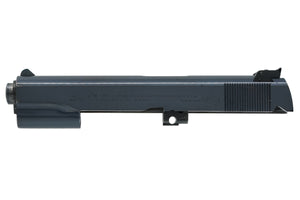
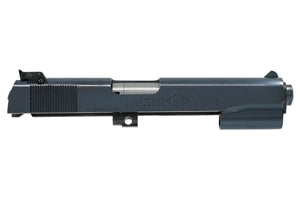
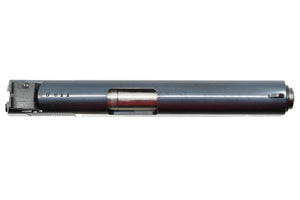
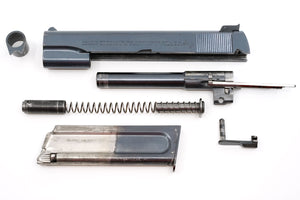
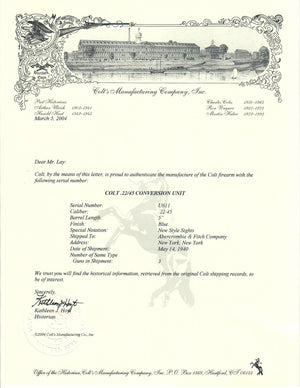
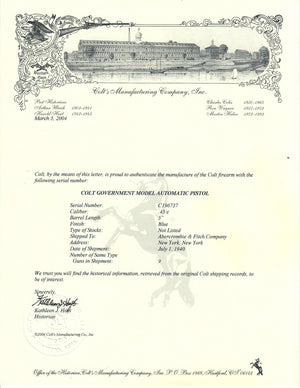
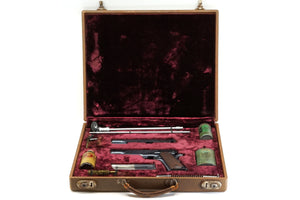
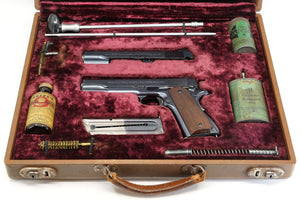
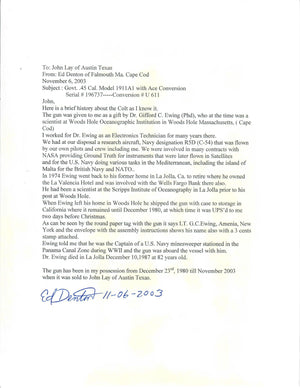
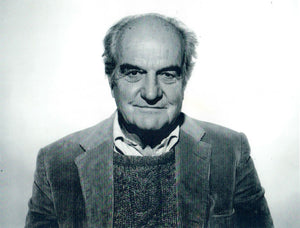
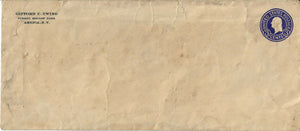
This Colt .22-45 Conversion Unit was shipped to the Abercrombie & Fitch Company in New York, New York on May 14th, 1940 in a 3 gun shipment. It notes on the factory letter that this shipped with the New Style Sights.
Abercrombie & Fitch would sell Colt Government Models with Conversion units in custom case that they would produce. This particular Conversion Unit was paired with Colt Government Model C196737 and sold together as a set to Dr. Gifford C. Ewing. Included in the case along with the Government Model and Conversion Unit is a bottle of Abercrombie & Fitch Genuine Rangoon Oil, Gun Cleaning Patches, Hoppe's 9 Powder Solvent, cleaning brushes and cleaning rods.
Gifford Ewing was born November 1, 1904 in Yonkers, New York, the sixth of seven children of Thomas an Anna (Cochran) Ewing. He was educated at St. Paul’s School in Concord, N.H. A.B. Yale University, 1926; M.S. UCLA, 1948; Ph.D. Physical Oceanography UCLA (based on work done at Scripps), 1950. He was married several times: Frances L. Riker (1926, divorced 1934); Alice R. Jones (1934, deceased 1964) and was survived by his wife Winifred Ely (1965). He had six daughters: Alexandra Whitney, Frances Rockwell, Jane Bailey, Eva, Deborah Singer, and Sabra. His obituary in the San Diego Tribune January 13, 1987 also lists two stepsons, Laurence Ely and Benton Jamieson, 17 grandchildren and two great grandchildren.
Ewing served as a laboratory instructor at Yale 1927-1928. He was an oceanographer at Bingham Oceanographic Laboratory at Yale 1929-1932. He was a member of the Yale Oceanographic Expedition of 1931-1932. His Scripps Curriculum Vitae says he was self employed and operated a dairy farm in Amenia, New York from 1932-1940.
Ewing spent summers in La Jolla with his family as a young man, but moved to the west coast in 1945. He was a naval reserve office and went on active duty as Captain, U.S. Navy 1940- 1945. Ewing advanced from a lieutenant j.g., ending his service as commander of a destroyer escort. He arrived at Scripps around 1948 and began work as a doctoral student in physical oceanography. He was an observer at the Operation Crossroads atomic test in 1946. He remained as Scripps after completing his doctorate and served as assistant research oceanographer, advanced to research oceanographer. He was chair of the Division of Oceanic Research. He was a pilot and owned his own airplane, and for years he worked with biologist Carl Hubbs to do aerial censuses of the California gray whale. This work proved that the gray whale was far from extinction, as has been asserted by some biologists. He also conducted aerial surveys with coastal geologist Douglas Inman and biologist Fred B. Phleger adding greatly to knowledge of coastal processes and biology of Baja California.
1964 Carl Hubbs whale trip to Baja California, here at Bahia de Los Angeles, Gifford Ewing is third from left. 21 February 1964
Dr. Ewing was the major owner, president and director of La Valencia Hotel in La Jolla, California for more than 30 years beginning in 1948. He had a business career that paralleled his career in oceanography.
Ewing moved to Woods Hole in 1964, although he continued an affiliation with Scripps until at least 1966. He organized the first conference on oceanography from space at WHOI in 1964. He served as a member of the corporation of the Woods Hole Oceanographic Institution. He also held an appointment in 1964 as visiting Scientist, Department of Geology and Geophysics, MIT. In an alumni directory published in 1978, Ewing wrote: “Defected to Woods Hole in 1964; conducted seminar on Oceanography from Space in Woods Hole 1964. Spent winter at MIT correcting everyone’s spelling. Spent next 14 years trying to get oceanography off the ground. Headed up an aerial survey of Eastern Mediterranean and another of Caribbean and Gulf of Mexico. Traveled to Germany, England, Italy, Malta and Israel. In 1978 we set out on a boat trip up the Nile but ended up in Mercy Hospital with a myocardial infarction. Moving back to Scripps – this time for keeps.”
Ewing had a long history of government service. He was a consultant at the Office of Naval Research beginning in 1951. He was a project officer for the Navy on Operation Wigwam in 1955. He chaired the Anti-Submarine Warfare Infrared Committee of the U.S. Navy in the 1961-1965. He was a member of the ad hoc advisory group on spacecraft for NAVOCEANO. He chaired an oceanographic team for the Apollo experiment for NASA, 1965.
Ewing received a substantial number of honors including the Medaille Albert 1er, Prince de Monaco (1964) which was given to him for his international work. He was a member of many clubs including the Cosmos Club and served on the boards of many organizations including the San Diego Zoo and the Natural History Museum in San Diego.
Ewing passed away at his home in La Jolla, California December 10, 1987.